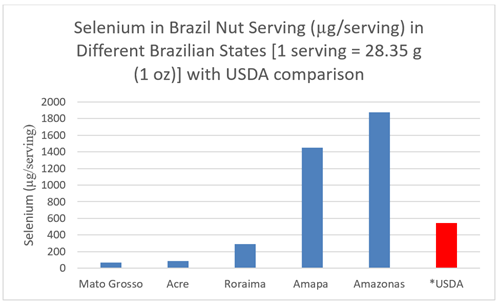
By Theodore Zava, ZRT Laboratory.
Selenium is a trace essential element that is incorporated into selenoproteins. There are at least 25 known selenoproteins in the human body, their primary roles being antioxidant enzymes such as glutathione peroxidase and thyroid deiodinases that convert thyroxine (T4) to active thyroid hormone (T3). Deficiencies in selenium can be detrimental to health, while selenium excess can be just as dangerous. Brazil nuts are commonly used as a form of selenium supplementation, but it isn’t commonly known that the level of selenium in Brazil nuts is highly variable.
Why Are Brazil Nuts High in Selenium?
Brazil nuts are well known for their high concentration of selenium. Soil conditions in parts of South America are unique in that they are deficient in sulfur, a necessary element required for the formation of the amino acids methionine and cysteine [1]. Selenium and sulfur are chemically very similar, so plants take up selenium in place of sulfur, forming the amino acids selenomethionine and selenocysteine. Soil often contains inorganic selenite and selenate, which are converted to organic selenomethionine and other methylated derivatives once taken up by the plant. Selenomethionine and selenocysteine can replace methionine and cysteine in proteins without loss of function.
Brazil nuts are well known for their high concentration of selenium; however, the amount of selenium is highly variable.
The amount of selenium in Brazil nuts is highly variable. Selenium content depends on the region in which the tree is grown, the pH of the soil, and can vary from nut to nut in a single batch or between trees [2]. According to the USDA, there is 96 µg of selenium per Brazil nut and 544 µg of selenium per serving [3]. A single serving of Brazil nuts is 28.35 grams (1 ounce), with individual nuts weighing around 5 grams. In a single study, Brazil nut selenium concentration ranged from 0.03 to 512 µg/g, a substantial difference [4]. At the highest concentration, a single serving of Brazil nuts (around 6 whole nuts) could result in a selenium intake of 14515 µg, much higher than the recommended daily amount (RDA) of 55 µg [5].Selenium Content of Brazil Nuts


Adapted from [2][3].
Daily Recommended Selenium Intake
The Institute of Medicine’s Food and Nutrition Board set a recommended dietary allowance of 55 µg selenium/day for adults with a tolerable upper intake level of 400 µg selenium/day [6]. Higher levels of selenium intake in the range of 200-300 µg/day are believed to be effective in the prevention of certain types of cancer such as lung, colon and prostate [7][8]. Adverse effects of selenium intake are seen above 1500 µg/day, with “selenosis” and DNA damage occurring above 3000 µg/day [9][10]. Selenium toxicity can result in hair loss, tremors, kidney failure, cardiac failure, neurological and gastrointestinal issues, respiratory distress and even death [6][11]. Due to the large variation of selenium in Brazil nuts, it is difficult to determine if Brazil nuts are providing inadequate, adequate, or excessive intake.
Brazil Nut Consumption and Antioxidant Levels
In a New Zealand study, 59 adults were separated into three groups, receiving either Brazil nuts (2 nuts a day or an estimated 100 µg selenium/day), selenomethionine tablets (100 µg selenium/day), or placebo tablets (no selenium) for 3 months [12]. Plasma selenium, plasma glutathione peroxidase (a selenium-containing antioxidant) and whole blood glutathione peroxidase were measured. Plasma selenium increased by 64%, 61% and 8%; plasma glutathione peroxidase by 8%, 5% and 1.2%; and whole blood glutathione peroxidase by 13%, 5% and 1.9%, in the Brazil nut, selenomethionine, and placebo groups, respectively. Brazil nuts, therefore, increase plasma selenium levels and antioxidant production in this human population.
How Much Selenium Am I Getting from Brazil Nuts?
Measuring the selenium content of Brazil nuts is complex and requires extensive digestion in the lab and time-consuming analytical procedures. Because other foods, beverages, and supplements provide selenium on top of Brazil nuts, it is best to measure total daily selenium intake. Around 50-70% of selenium ingested is excreted in urine, therefore the amount of selenium in urine is proportional to the amount ingested [13][14]. If you are planning on supplementing with Brazil nuts, it is highly recommended that you test your urine selenium levels to determine if safe levels of selenium are being consumed. ZRT Laboratory offers a urine selenium test that also measures other essential and toxic elements.
Related Tests
Heavy Metals and Nutrients Test
References
1. Pacheco AM, Scussel VM. Selenium and aflatoxin levels in raw Brazil nuts from the Amazon basin. J Agric Food Chem. 2007;55:11087-92.
2. Silva Junior EC, et al. Natural variation of selenium in Brazil nuts and soils from the Amazon region. Chemosphere. 2017;188:650-658.
3. S. Department of Agriculture, Agricultural Research Service. USDA National Nutrient Database for Standard Reference, Release 25. Nutrient Data Laboratory Home Page, 2012.
4. Chang JC, et al. Selenium content of Brazil nuts from two geographic locations in Brazil. Chemosphere. 1995;30:801-2.
5. https://ods.od.nih.gov/factsheets/Selenium-HealthProfessional/
6. Institute of Medicine, Food and Nutrition Board. Dietary Reference Intakes: Vitamin C, Vitamin E, Selenium, and Carotenoids. National Academy Press, Washington, DC, 2000.
7. Combs GF Jr. Considering the mechanisms of cancer prevention by selenium. Adv Exp Med Biol. 2001;492:107-17.
8. Rayman MP. Selenium in cancer prevention: a review of the evidence and mechanism of action. Proc Nutr Soc. 2005;64:527-42.
9. Reid ME,. A report of high-dose selenium supplementation: response and toxicities. J Trace Elem Med Biol. 2004;18:69-74.
10. Whanger PD. Selenium and its relationship to cancer: an update. Br J Nutr. 2004;91:11-28.
11. Sunde RA. Selenium. In: Bowman B, Russell R, eds. Present Knowledge in Nutrition. 9th ed. Washington, DC: International Life Sciences Institute; 2006:480-97.
12. Thomson CD, et al. Brazil nuts: an effective way to improve selenium status. Am J Clin Nutr. 2008;87:379-84.
13. Suzuki K. Metabolomics of selenium: Se metabolites based on speciation studies. Journal of Health Science. 2005;51:107-14.
14. Sanz Alaejos M, Díaz Romero C. Urinary selenium concentrations. Clin Chem. 1993;39:2040-52.

